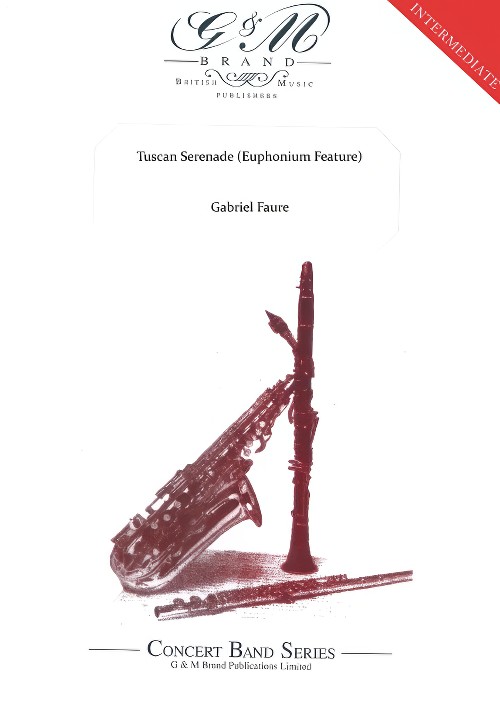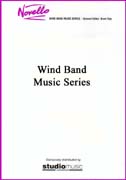Results
-
 £84.95
£84.95Tuscan Serenade (Euphonium Solo) (Concert Band - Score and Parts) - Faure, Gabriel - Grainger, Percy
Hauntingly beautiful, Grainger captures the essence of Faure's song. A lovely euphonium solo sings the melody before the full ensemble expresses the mood of Tuscany and the poem that the Faure song is based upon.
Estimated dispatch 7-14 working days
-
 £16.95
£16.95Tuscan Serenade (Euphonium Solo) (Concert Band - Score Only) - Faure, Gabriel - Grainger, Percy
Hauntingly beautiful, Grainger captures the essence of Faure's song. A lovely euphonium solo sings the melody before the full ensemble expresses the mood of Tuscany and the poem that the Faure song is based upon.
Estimated dispatch 7-14 working days
-
 £84.99
£84.99Die Post im Walde Wind Band Set (Score & Parts)
During his lifetime, Heinrich Schaffer (1808-1874) was a famous singerand singing teacher. With his compositions for male-voice choir, hewas very influential in northern Germany. Nowadays, little is left ofthis man?s fame. Only his song Die Post im Walde is regularly performedwith much enjoyment by many men?s choirs. This beautiful song is nowavailable for trumpet and concert band. 0:04:30
Estimated dispatch 7-14 working days
-
 £76.99
£76.99Happy Together (Concert Band - Score and Parts)
The pop group, The Turtles, were one of the best-known bands during the 1960s with nine top 30 hits. This was quite an accomplishment considering that this era was dominated by megastars such as The Beatles, The Rolling Stones, Motown and other huge names. In 1966 The Turtles released the love song Happy Together which gave them their first number one hit single. Today this song, with its catchy chorus, is regarded as an evergreen and this arrangement will make a welcome addition to your light concert repertoire. 03:00
Estimated dispatch 7-14 working days
-
 £32.95
£32.95SUITE OF ENGLISH FOLKDANCES (Symphonic WB Extra Score) - Tomlinson, Ernest
Extra score only. In 1951 Ernest Tomlinson, at the invitation of his sister Freda, attended a Festival of Dance and Song presented by the English Folk Dance and Song Society. He was so captivated by the tunes danced to, that he resolved to write an orchestral suite based on some of them. The composer's arrangement for wind band follows closely the textures and colour contrasts of the orchestral original. The Suite, which is dedicated to his sister, is in six movements, all the tunes being selected from the first edition of John Playford's The English Dancing Master. Includes: Jenny Pluck Pears; Ten Pound Lass; Dick's Maggot; Nonesuch; Hunt the Squirrel; Woodicock. Duration: 12 mins.
Estimated dispatch 7-14 working days
-
 £164.95
£164.95SUITE OF ENGLISH FOLKDANCES (Symphonic WB) - Tomlinson, Ernest
Score & Parts. In 1951 Ernest Tomlinson, at the invitation of his sister Freda, attended a Festival of Dance and Song presented by the English Folk Dance and Song Society. He was so captivated by the tunes danced to, that he resolved to write an orchestral suite based on some of them. The composer's arrangement for wind band follows closely the textures and colour contrasts of the orchestral original. The Suite, which is dedicated to his sister, is in six movements, all the tunes being selected from the first edition of John Playford's The English Dancing Master. Includes: Jenny Pluck Pears; Ten Pound Lass; Dick's Maggot; Nonesuch; Hunt the Squirrel; Woodicock. Duration: 12 mins.
Estimated dispatch 7-14 working days
-
 £84.99
£84.99Don't Start Now
'Don't Start Now', by the British singer Dua Lipa, is the first single from her second studio album, Future Nostalgia. The accompanying music video was uploaded to her YouTube channel upon the single's release. In the song, the singer tells her ex-lover that she is now over him. She gave her first live performance of it on The Graham Norton Show, after that she sang it a number of times at various award shows, TV programmes and music festivals. This arrangement by Tom Stanford will make sure that this disco pop song will also find its way into the world of wind music.
Estimated dispatch 7-14 working days
-
 £53.50
£53.50Green Bushes
Through the years this well-known English folk song has been a favorite with composers including Ralph Vaughan Williams (English Folk Song Suite) and George Butterworth (The Bank of Green Willow). One of the best-known versions of Percy Grainger's 1921 setting for two pianos, and this delightful arrangement for young bands is based in part on Grainger's version. Dur: 2:45
Estimated dispatch 7-14 working days
-
 £115.60
£115.60Det vakreste som fins - John Teigen
The most beautiful thing is one of Jahn Teigens most popular pop ballads. It was written in 1988 together with Rolf Lvland and Ove Borchstein and went straight to the top of the Norwegian hitlists. Even 20 years after its release, in 2008, it reached the hitlists after Teigen performed it during the Eurovision Song Contest. The song is often played on Norwegian radio and was the 70th most played in the period 1993-2013 on the radio channel P4. Now it's finally arranged for band in the popular Young Band series with adaptation of key that fit young musicians. It will definitely be a popular number in your next concert.
Estimated dispatch 7-14 working days
-
 £71.50
£71.50An Irish Legend - Joseph Eidson
An Irish Legend uses the traditional Irish folk song The Minstrel Boy as the melodic material in this piece. The inspirational and emotional lyrics portray the loss of several friends in the 1798 rebellion of the United Irishmen. One of the lasting messages of this song is freedom from slavery and tyranny - a powerful message that has touched many people fighting for their country. The sense of longing, loss, and triumph found in the lyrics is reflected in the somber and lyrical style of this setting for concert band.
Estimated dispatch 7-14 working days
